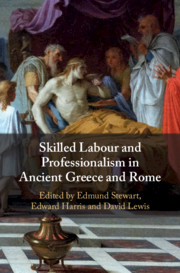Book contents
- Skilled Labour and Professionalism in Ancient Greece and Rome
- Skilled Labour and Professionalism in Ancient Greece and Rome
- Copyright page
- Contents
- Illustrations
- Contributors
- Acknowledgements
- Abbreviations
- Introduction
- Part I Professionals and Professional Identity in Greece and Rome
- 1 Many Ancient Greek Occupations, but Few Professions
- 2 Skilled Workers in the Ancient Greek City: Public Employment, Selection Methods, and Evaluation
- 3 Money Making, ‘Avarice’, and Elite Strategies of Distinction in the Roman World
- Part II Specialization and the Division of Labour in the Ancient City
- Part III Case Studies of Professions 1: Sculpture
- Part IV Case Studies of Professions 2: Music and Athletics
- Part V Case Studies of Professions 3: A Profession of Arms?
- Index
- References
2 - Skilled Workers in the Ancient Greek City: Public Employment, Selection Methods, and Evaluation
from Part I - Professionals and Professional Identity in Greece and Rome
Published online by Cambridge University Press: 18 September 2020
- Skilled Labour and Professionalism in Ancient Greece and Rome
- Skilled Labour and Professionalism in Ancient Greece and Rome
- Copyright page
- Contents
- Illustrations
- Contributors
- Acknowledgements
- Abbreviations
- Introduction
- Part I Professionals and Professional Identity in Greece and Rome
- 1 Many Ancient Greek Occupations, but Few Professions
- 2 Skilled Workers in the Ancient Greek City: Public Employment, Selection Methods, and Evaluation
- 3 Money Making, ‘Avarice’, and Elite Strategies of Distinction in the Roman World
- Part II Specialization and the Division of Labour in the Ancient City
- Part III Case Studies of Professions 1: Sculpture
- Part IV Case Studies of Professions 2: Music and Athletics
- Part V Case Studies of Professions 3: A Profession of Arms?
- Index
- References
Summary
Cities selected and recruited skilled workers for various tasks, offering them contracts, payment and rewards. These will all be examined as well as the technitai’s travels, and the poleis’ assessment and appreciation of individuals and professions as a whole (especially doctors, seers, and architects).
- Type
- Chapter
- Information
- Publisher: Cambridge University PressPrint publication year: 2020



